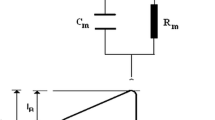Abstract
Ionophoric activities of an N-terminus truncated gramicidin A (gA) analogue (mini-gramicidin) and its covalent dimer were studied in planar bilayer phospholipid membranes (BLM) using macroscopic current measurements (at high concentrations of the peptides) and single-channel recordings. As with gA-induced currents, mini-gramicidin-stimulated macroscopic currents through BLM underwent sensitized photoinactivation, i.e. were suppressed after irradiation with visible light in the presence of a photosensitizer generating singlet oxygen. The sensitivity of the tested compounds to photoinactivation descended in the following order: minigramicidin dimer > mini-gramicidin monomer > gA. The data from single-channel measurements and kinetic analysis of flash-induced photoinactivation obtained at different levels of macroscopic currents suggest that mini-gramicidin and its covalent dimer induce a variety of conducting states; their ratio depends on membrane thickness. Analysis of natural (mitochondrial and erythrocyte) membranes established that ionophoric activities of mini-gramicidin and its covalent dimer depend essentially on the membrane type.
Similar content being viewed by others
Abbreviations
- BLM:
-
bilayer lipid membrane
- AlPcS3 :
-
trisulfonated aluminum phthalocyanine
- DPhPC:
-
diphytanoylphosphaditylcholine
- POPC:
-
palmitoyloleoylphosphaditylcholine
References
Kelkar, D.A. and Chattopadhyay, A., The Gramicidin Ion Channel: A Model Membrane Protein, Biochim. et Biophys. Acta, 2007, vol. 1768, pp. 2011–2025.
Arseniev, A.S., Barsukov, I.L., Bystrov, V.F., Lomize A.L., and Ovchinnikov, Y.A., NMR Study of Gramicidin A Transmembrane Ion Channel. Head-to-Head RightHanded, Single-Stranded Helices, Febs Lett., 1985, vol. 186, pp. 168–174.
Hladky, S.B. and Haydon, D.A., Ion Movements in Gramicidin Channels, Curr Topics Membrane Transport, 1984, vol. 21, pp. 327–372.
Kotova, E.A. and Antonenko, Y.N., Sensitized Photoinactivation of Gramicidin Channels: Technique and Applications, Advances in Planar Lipid Bilayers and Liposomes, Tien, H.T. and Ottova-Leitmannova, A., Eds., Amsterdam: Academic Press, 2005, pp. 159–180.
Hamill, O.P. and Martinac, B., Molecular Basis of Mechanotransduction in Living Cells, Physiol. Rev., 2001, vol. 81, pp. 685–740.
Arndt, H.D., Knoll A., and Koert, U., Synthesis of Minigramicidin Ion Channels and Test of Their Hydrophobic Match with the Membrane, Chembiochem., 2001, vol. 2, pp. 221–223.
Arndt, H.D., Bockelmann, D., Knoll, A., Lamberth, S., Griesinger, C., and Koert, U., Cation Control in Functional Helical Programming: Structures of A D,L-Peptide Ion Channel, Angew. Chem. Int. Ed., 2002, vol. 41, pp. 4062–4065.
Mueller, P., Rudin, D.O., Tien, H.T., and Wescott, W.C., Methods for the Formation of Single Bimolecular Lipid Membrane in Aqueous Solution, J. Phys. Chem., 1963, vol. 67, pp. 534–535.
Rokitskaya, T.I., Antonenko, Yu.N., and Kotova, E.A., The Interaction of Phthalocyanine with Planar Lipid Bilayers: Photodynamic Inactivation of Gramicidin Channels, FEES Lett., 1993, vol. 329, pp. 332–335.
Rokitskaya, T.I., Antonenko, Yu.N., and Kotova, E.A., Photodynamic Inactivation of Gramicidin Channels: A Flash-Photolysis Study, Biochim. et Biophys. Acta, 1996, vol. 1275, pp. 221–226.
Rokitskaya, T.I., Block, M., Antonenko, Y.N., Kotova, E.A., and Pohl, P., Photosensitizer Binding to Lipid Bilayers As a Precondition for the Photoinactivation of Mem brane Channels, Biophys. J., 2000, vol. 78, pp. 2572–2580.
Antonenko, Yu.N., Kotova, E.A., and Rokitskaya, T.I., Photodynamic Effect As a Basis for the Relaxation Approach to the Study of Gramicidin Channels, Biologicheskie Membrany (Rus.), 2005, vol. 22, pp. 275–289.
Straessle, M. and Stark, G., Photodynamic Inactivation of an Ion Channel: Gramicidin A, Photochem. Photobiol., 1992, vol. 55, pp. 461–463.
Woolley, G.A., Kapral, M.K., and Deber, C.M., Potential-Sensitive Membrane Association of a Fluorescent Dye, FEES Lett., 1987, vol. 224, pp. 337–342.
Kotova, E.A., Rokitskaya, T.I., and Antonenko, Yu.N., Two Phases of Gramicidin Photoinactivation in Bilayer Lipid Membranes in the Presence of a Photosensitizer, Biologicheskiye Membrany (Rus.), 1999, vol. 16, pp. 336–343.
Lavi, A., Weitman, H., Holmes, R.T., Smith, K.M., and Ehrenberg, B., The Depth of Porphyrin in a Membrane and the Membrane's Physical Properties Affect the Pho tosensitizing Efficiency, Biophys. J., 2002, vol. 82, pp. 2101–2110.
White, S.H., Formation of “Solvent-Free” Black Lipid Bilayer Membranes from Glyceryl Monooleate Dispersed in Squalene, Biophys. J., 1978, vol. 23, pp. 337–347.
Sychev, S.V., Sukhanov, S.V., Barsukov, L.I., and Ivanov, V.T., Structural Polymorphism of Gramicidin A Channels: Ion Conductivity and Spectral Studies, J. Peptide Sci., 1996, vol. 2, pp. 141–156.
Mobashery, N., Nielsen, C., and Andersen, O.S., The Conformational Preference of Gramicidin Channels Is a Function of Lipid Bilayer Thickness, FEES Lett., 1997, vol. 412, pp. 15–20.
Lougheed, T., Borisenko, V., Hand, C.E., and Woolley, G.A., Fluorescent Gramicidin Derivatives for Single-Molecule Fluorescence and Ion Channel Measurements, Bioconjug. Chem., 2001, vol. 12, pp. 594–602.
Rottenberg, H. and Koeppe, R.E., Mechanism of Uncoupling of Oxidative Phosphorylation by Gramicidin, Biochemistry, 1989, vol. 28, pp. 4355–4360.
Bunting, J.R., Influx and Efflux Kinetics of Cationic Dye Binding to Respiring Mitochondria, Biophys. Chem., 1992, vol. 42, pp. 163–175.
Pratap, PR., Novak, T.S., and Freedman, J.C., Two Mechanisms by Which Fluorescent Oxonols Indicate Membrane Potential in Human Red Blood Cells, Biophys. J., 1990, vol. 57, pp. 835–849.
Author information
Authors and Affiliations
Additional information
Original Russian Text © E.A. Dutseva, E.A. Kotova, Yu.N. Antonenko, 2008, published in Biologicheskie Membrany, 2008, Vol. 25, No. 1, pp. 58–65.
Rights and permissions
About this article
Cite this article
Dutseva, E.A., Kotova, E.A. & Antonenko, Y.N. Ionophoric activity of truncated gramicidin A analogue in phospholipid bilayers and mitochondrial and erythrocyte membranes. Biochem. Moscow Suppl. Ser. A 2, 55–61 (2008). https://doi.org/10.1007/s11827-008-1009-4
Received:
Published:
Issue Date:
DOI: https://doi.org/10.1007/s11827-008-1009-4



